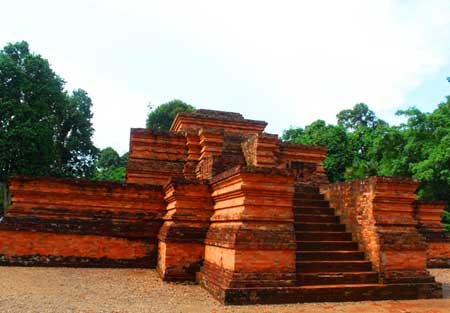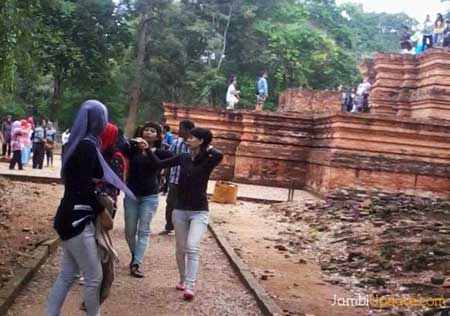Archaeological Site Candi Muaro Edinburgh is one of the largest archaeological heritage in Indonesia, which goes from west to east as far 7.5 km along the Batang Hari River Bank to the extent of about 12 square kilometers. A small part is in the western part of the river Batang Hari. The remains of the side of the East River is administratively included in Desa Muarojambi & Village Lake Lamo. The river is located in the West Village Kemingking In District. Muaro Sebo -. District Muarojambi
Archaeological Sites Complex enshrinement Muara Jambi is located about 26 kilometers east of the city of Jambi on ancient natural levees day Sungai Batang. This site has an area of 12 square kilometers, more than 7 km in length and width of about 260 hectares that extends in the direction of river channels. The site contains 61 temples which were mostly still a mound of earth or menapo are still occupied. Inside the temple complex there are also buildings with shades of Hinduism. Muara Jambi temple geologists are estimated from the 11th century, which was built during the Srivijaya kingdom. The temple is a temple complex Muarojambi the largest and best preserved on the island of Sumatra. entrenchment of the site as a complex area Muarojambi Buddhist education center

Image :. firgi.pun.bz
Candi Muara Jambi is a precious cultural heritage of building high-rise where the old temple and ruins indicate that in the past, this temple was once the center of worship for followers of Tantric Mahayana Buddhism. This is evident from the various findings such as Arca Prajnaparamita means of rituals, the ruins of the stupa, there is also elephant statues Singha, Vajra iron and also written a special mantra engraved on a gold plate or scrawled on the brick. Among the numerous inscribed bricks, there is the syllable "Wijaksana" then there is the term "Vajra" on a golden plate, and NAGARI script on a stone that reads "tra-tra".
Invention is another form of beads, pottery, broken tiles, jewelry and the remains of appliances which proves that the regional area surrounding the temple complex are also a residential area, undoubtedly becoming stronger dwelling place for the monks and Buddha students in the past. In addition, this site also found many traces in the form of ceramics from China during the Song Dynasty (around 11-12 century AD), which indicates the existence of international relations that existed at the time . Although the discovery of ceramics in Europe in the 19th century also prove their excavations ever undertaken by a British officer and the Dutch scholar of 19-20 century. Also read :. Magic Lake Kaco Jambi Lights At Night

Image: jambiupdate.com
Based on the ancient Javanese script writing, on several sheets relics of the plate thought to date from the 9th to the 12th century. On the site a new 9 buildings restored and everything has a Buddhist style. Ninth of the temple is that the temple Kotomahligai, Kedaton Temple, Gedong 1 2 Gedong, Candi_Gumpung, Candi_Tinggi, Temple Telago Rajo, twin temple Stone & temple, Astano. Among the many discoveries found in the area, this territory was once expected to be one of the places of meeting various cultures. There are beads of relics that came from Persia, China and India. Suspected of Mahayana Buddhism Tantrayana This mandala is the religion of the majority of the time with the discovery of the plates that read 'Vajra' in some temples were also formed.
In the temple site of the complex is not only the temple but also store a variety of other ancient objects such as statues, ceramics, ancient coins, beads and other. There are also 8 the temple complex, ancient pool, which by the locals called Swimming Telago Rajo and also estimated that more than 60 pieces or menapo rubble mound are the remains of ancient buildings.
Initially, Muaro Jambi temple site was not very popular and known only to local residents. New in 1820, the site began to unfold in this limited entrenchment after arrival S.C. Crooke, he was a British officer whose job is to map the river Batang Hari. It mendapakant reports from local residents about their ancient relics in the Village Muarojambi region. In addition, in 1935, until 1936, a Dutch scientist, namely F. M. Schnitger in purbakalanya expedition to Sumatra was excavated on the site Muarojambi. Since Muarojambi be known and began in 1976 to the present, with serious and progressive, conducted the research and preservation of archaeological sites to be saved and historical heritage in the site Muarojambi. Muaro Jambi temple when it was still found in the form of stacked bricks. Some are stacked and formed a stupa shaped like Candi other Buddhist.
Ministry of Culture and Tourism of Jambi province recorded the this historic temple as a World Heritage of Unesco to United Nations United (UN). The move is an effort to make this Muarojambi temple as a World Heritage. immediate positive impact of the proposal, tourist arrivals will increase in Jambi province. In addition, writers, scientists and writers will be many who came to be studied and written about this temple.
Since 07, restoration efforts and the construction of a temple on the ruins menapo- Muaro jambi success rediscovered do. The site is also used again as a part of various ceremonies religious holidays for Buddhists, even those sites is so essential to the implementation of the feast of Vesak celebrations that happen in the national agenda in over Borobudur. [Source: indonesia.travel]
Tidak ada komentar:
Posting Komentar